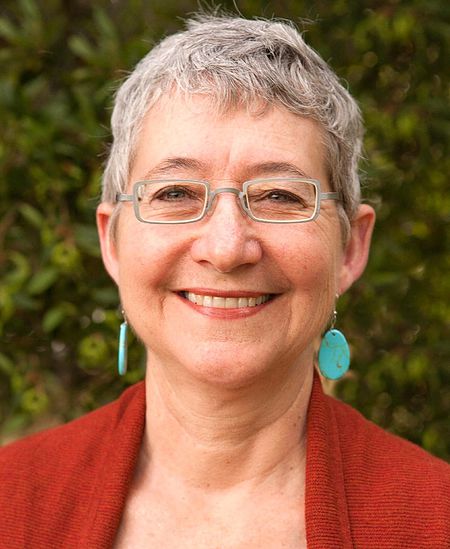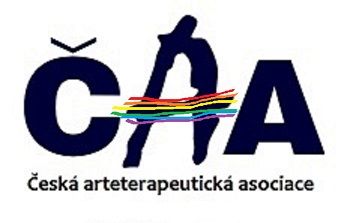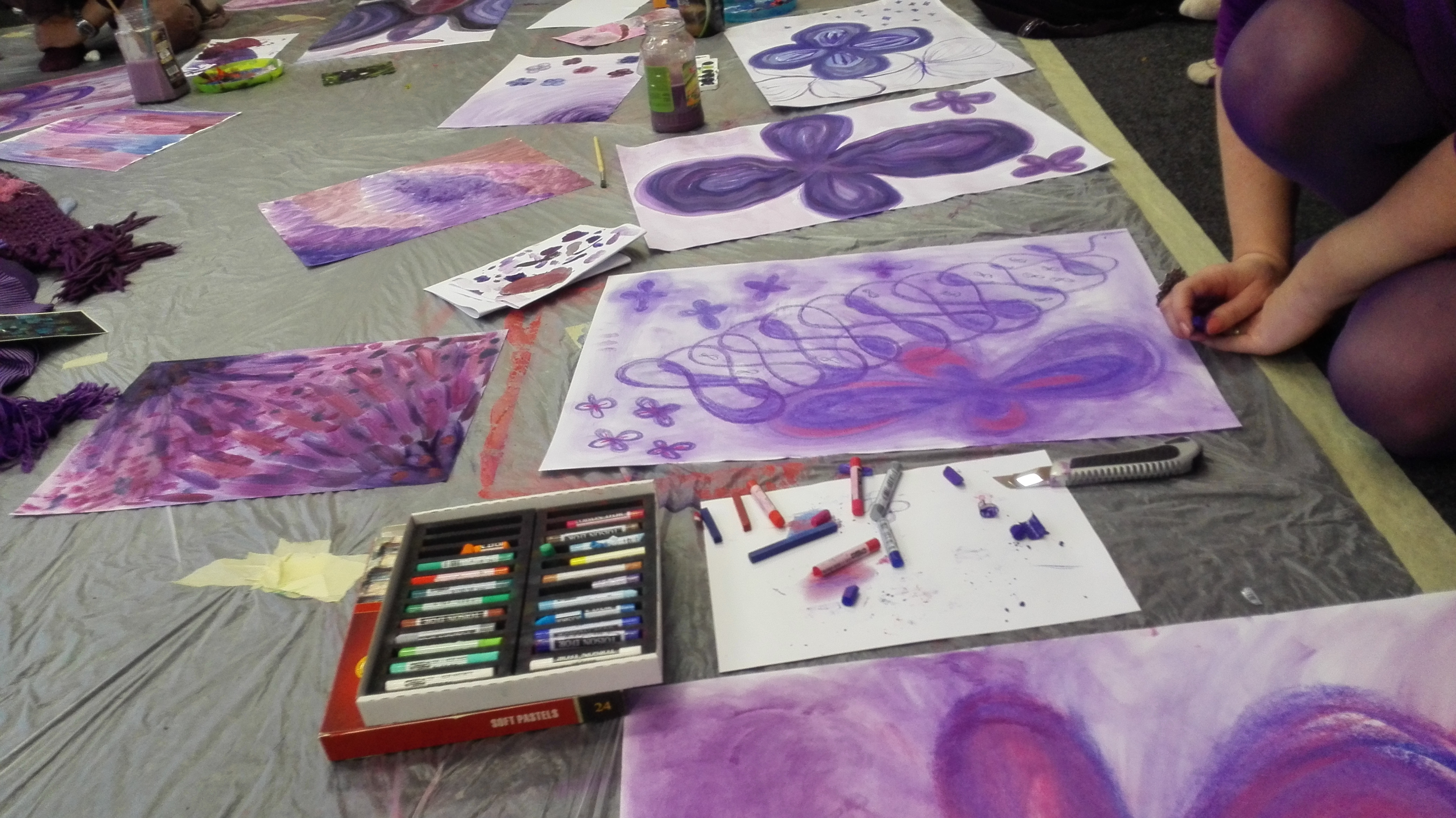 In spring 2014 I traveled to California and I had a wish to meet with some colleague and talk about art therapy in USA. I would like to thank to Barbara Petterson who found a time for our meeting and helped a lot that this interview could happened. Andrea Hanzlová
In spring 2014 I traveled to California and I had a wish to meet with some colleague and talk about art therapy in USA. I would like to thank to Barbara Petterson who found a time for our meeting and helped a lot that this interview could happened. Andrea Hanzlová
AH: You work in different fields of therapy, such as family therapy, but first let’s focus on art therapy and what it means in America, because in some countries art therapy is drawing, painting and clay, and others such as music therapy and dance therapy are something different. Do you use the phrase “expressive arts”?
BP: In the US, most art therapy is similar to what you said. It’s painting, drawing, clay, collage, different visual arts, and when I went to school at Notre Dame de Namur University in Belmont, California, that’s what most of the training was. I did have a teacher who was an expressive arts therapist and we also learnt to do movement and singing, poetry, a variety of things, and there are many art therapists who use other modalities.
I use music and singing in my work often, but we also have music therapists here, dance, drama, and expressive arts therapists so we’re still kind of two different things with people learning from each other and using what makes sense.
AH: Can you tell me something about the development of art therapy in California? How it’s improved and how it’s improving?
BP: Ok, I know my program was started in, I think, the 1970’s by Doris Arrington, who is still around, she’s still working in that program. It was probably one of the first in California
and one of the challenges for art therapists, which sounds similar to you in your Czech Republic, is there is no recognized license for art therapists in California so at some point, what my school did and I think most of the programs in California did, is they started offering training to also be marriage and family therapists, so most people get a Master’s degree in Marriage and Family Therapy and Art Therapy. It’s one degree, but they get trained in both.
That way you can get licensed as Marriage and Family Therapists. They can work and see clients under their own license in California and then they also work towards the ATR which is the Art Therapy Registration, which is a national ATR. The American Art Therapy Association (AATA) decided to create a credential to bring more recognition to the field and they created the Art Therapy Credential Board, so that’s who gives people their Art Therapy Registration.
I’m still working towards my Art Therapy Registration because I was licensed a long time ago
as a Marriage and Family Therapist and went back to school to become an art therapist. So I
am gaining hours as an art therapist as you have to earn a certain amount of hours working
with clients and you have to get art therapy supervision.
Both for Marriage and Family Therapists and art therapists there’s a lot of difference from
state to state about how they are viewed and what you have to do to get licensed. Some states
recognize art therapists on their own and some don’t so that’s a challenge and I think art
therapists are still trying to find recognition for what they do. I know there is a lot of emphasis
right now on doing research and using that research to help establish Art Therapy.
AH: Are there some differences in the use of art therapy in different regions of the States?
BP: You know that’s a good question. I am sure there are some differences. When I’ve gone
to the AATA conferences, I’ve met people from all over and I do think people are influenced
by the region. I can think of a couple of therapists who live in the South, where quilting and
making clothing is a very strong tradition and they use quilting and textiles in their work.
They might use textiles like fabric in art making, it might be sewing, it might be gluing, but
it’s probably partly from their own background, their communities, their culture. Also, in
Chicago, there’s a graduate art therapy program at the Art Institute of Chicago. I think they
probably have a little stronger foundation in art making than my program did. I believe they
have what’s called the “open studio” model where students are expected to spend a certain
amount of time making their own art at school. In my program we made a lot of art in
different classes, but we didn’t just go to the studio and make art, so that might be a regional
difference, or a difference because they’re associated with an art school.
AH: So how is art therapy held compared with psychotherapy, psychology, maybe
psychiatry?
BP: I think that it’s often true that it’s seen as a lower discipline here and again that
recognition is the challenge that we are trying to work on. Psychiatrists and Licensed
Psychologists have strong national organizations that do a lot of lobbying and advocacy, and
have worked with legislators to pass laws. Marriage and Family Therapists are below that, a
little below Licensed Clinical Social Workers. In California, they’ve got quite a bit of
recognition but there are still some national kinds of funding like for the Veterans
Association, at least I think now, that still don’t pay for Marriage and Family Therapist’s
work, and art therapists often have to work under someone else or are seen as lower down.
But I think it’s changing. It’s a small thing that’s growing, but I think there’s more and more
recognition right now with so much research going on, for example about trauma and the
brain. There’s more and more recognition that art therapy can really work in ways that verbal
therapy can’t by itself. But again, it is still very much an issue we are working on.
AH: So we talked about recognition and a little about programs leading to becoming an art
therapist. Ultimately, what is necessary for somebody to become an art therapist in the US?
BP: It is good to look on AATA’s website, and also it would be good to look at the Art
Therapy Credentials Board (ATCB) website because that’s where it says specifically what
you need. Basically, you have to get a Master’s Degree in Art Therapy in which there is
certain course work covering both psychology and use of art and probably family therapy, law
and ethics. You study ageing, drug and alcohol abuse, working with children, working with
people with disabilities, a variety of populations, working with groups, things like that. And
then you have to get a certain amount of hours working with clients, which depends on the
program, whether it’s approved or unapproved, but it’s about 2000 to 3000 hours depending
on what track you take, and you need to get supervision from an art therapist to get those
hours. You can also get supervision from another kind of therapist, but for a limited number
of hours. Then you have to turn in your application and take an exam to get your credential.
AH: And what was your own path? Tell me a little more about that.
B.: Well, I always did a lot of art as a child and I loved it. It was part of how I took care of
myself and dealt with difficult things, and as an adult I’ve done it a lot, but not as much as I
wanted and it wasn’t until after I went to school and got my first Master’s Degree in
Counseling that I found out about art therapy. I had a supervisor who was an art therapist and
then I supervised people who were training to become art therapists. I ran a school-based
counseling program and I was envious of them. I wanted to do the same thing. The agency
where I was working had government funding that kept shrinking so when we had to close the
organization, I knew I wanted to do something different.
I decided to go back to school in art therapy because for many years I’d mainly been
supervising and not working with clients myself. I felt like I needed to work on my skills and
I wanted this new tool for me, this tool that I felt could really be so helpful. Also, my mother
had dementia and I wanted to learn about how to work with people with such a condition so
that was another reason I went back to school.
I did an internship with the Alzheimer’s Association, which was wonderful. I did it for a year
where I was doing art therapy groups with older adults with dementia and that was just
wonderful. So now I still work with older adults, but I also have a private practice where I
work with adults of all ages and I use art with most of my clients. Some don’t want to use it,
but most of them do.
AH: And do you have any contact with European or other national associations?
BP: Really, the only way I have contact is through the International Art Therapy Association
and a couple of their art therapy groups on LinkedIn. I’m curious whether other local art
therapists have contact with the European market. Since my school is on the west coast, we
get a lot of students from Asia in my program so I have friends now who are art therapists
there. I have a friend who’s from Singapore, another friend in Hong Kong, and many of my
professors go to Asia quite a bit to do training so that’s really nice to see art therapy
developing there too.
AH: And how has your approach to art therapy changed since you started?
BP: Well, one of the things I learned in school is to really follow the client so I think before I
thought of it more on the outside and now it’s inside. Like really paying attention to what
things are important to the client and what materials they respond to, what directives they
respond to, and I learned that it’s about the relationship between the client and the therapist so
it doesn’t make sense for me to just bring in some idea and, they may like it or may not like it,
but if I really learn about them it helps me to have ideas come up about what might be helpful
to them.
That’s one thought. Also, I’ve become more comfortable using other modalities such as
singing, partly because we did that in some of our classes, and to recognize that when you do
use more than one modality they build on each other.
AH: And do you have any preference for some material?
BP: That’s an area where I sometimes feel like I need to challenge myself more. Part of it’s
logistical because I travel to see some of my clients where they live in skilled-nursing or
elder-care settings, and then I share my offices with other people so I have to think about how
messy I can be, but I use oil pastels a lot with people, and one thing I love is making
mandalas. I use some nice black paper and I use silver Sharpie pens and trace a circle and then
just create designs from my mind, try to make fairly simple designs, and then with either
individuals or groups, I just bring a bunch of them and let people choose which one they’d
like to work on and then have either oil pastels or really nice color pencils available.
I find mandalas amazing because a lot of the clients I work with are agitated, or have
dementia and are anxious and upset, or are people dealing with illness or dying, and there’s
something about working with mandalas which is very soothing, very centering. Some of my
professors have me present to their classes and I always have the students do art and I always
bring mandalas. No matter who it is or what age, people love them. And there’s something
about having them on the black paper, something very powerful about it and the way the
colors show up on there.
AH: You sound like you are more focused on process. That you don’t bring a theme but rather
focus on the process of the client, what they are bringing?
BP: Yes, I try to respond to the theme of the client. With some of my groups with older adults
take place within activity programs and are not necessarily seen as therapy, so sometimes I do
bring a theme such as Springtime or Friendship, and I might bring a particular thing for
people to do. I find that people make it their own, but I also try often to just let people come
up with their own themes.
AH: So who are your patients or clients?
BP: Well right now, I do groups with older adults in what’s called an assisted living center.
It’s a place where people, usually families, send their older loved ones to live. A lot of
families don’t have the person living with them and it’s usually when the person is no longer
able to take care of themselves; maybe their nutrition is suffering, their health. Maybe, there’s
some dementia, some memory loss or confusion, or they might be having physical problems
where they can’t do things as well as they used to, so they live in an assisted living center
where they get meals, they have someone clean their apartment, things like that, and they also
have these activity programs. So that’s where I see some of my clients and that’s mostly
people who have a pretty good amount of money because Medicare or the government
doesn’t pay for that so it’s families who have some money.
I also see a couple of clients who are in nursing homes; one woman who has very advanced
dementia and uses a wheelchair. Her arms are crossed over and she has very little speech so I
usually take her outside in the courtyard. I sing to her and sometimes I’m able to help her to
do a little painting, but it’s very tiny movements so a lot of it’s just about trying to engage
with her and also do something that feels good or pleasurable or soothing. Another client I’m
working with is much more cognitively present so I have her do art and then talk about it with
her and what the meaning of it is. We also talk about other things.
And then I work with adults, from younger adults to older adults and some of them really love
doing art and some of them not so much. If we’re talking about something and I think it
would be helpful for them to make art, I’ll ask if they would like to do that about the
particular issue that we’re discussing.
AH: Do you yourself paint?
BP: I do more drawing than painting. I have journals where I do a lot of mandalas just with
felt tip pen and then sometimes I color them in with pastels, colored pencils or watercolors.
And then I like using pastels myself, oil or chalk, so I do just kind of free drawings, and I do
also like to paint with acrylics.
I don’t do so much. Sometimes just free drawings of whatever comes up and sometimes a
picture of my family or something. I do some collage too, which I like because it’s less
threatening or something. Once in a while I do something else, working with clay or working
with wire.
AH: Who has inspired you the most?
BP: Let’s see. Quite a few people. I think early on Charlene Kohl Kelzer, my supervisor who
was an art therapist, because she had a very comfortable way of sitting down with someone
and when we would do art during supervision as a group she really made it comfortable to do
art. I have a former professor, Laury Rappaport, who is very inspiring. She created Focusing
Oriented Art Therapy and has written about it and does a lot of training in it.
Another professor, Arnell Etherington, who lives in England now, is an expressive arts
therapist and I found that very exciting. She’s very comfortable. She was very good at getting
us singing, dancing and moving, and making poetry and doing things together, for example,
one person would start the picture and then we’d pass it on to the next person and make a
group picture. Things that got us really interacting.
Another professor, Lisa Manthe, taught a class on ethics and I think we all struggled in that
class. She had us make a lot of our own art about issues. She also taught about adolescents
and she brought in very unusual materials, mirrors and big bolts of wire, and things made of
metal, blue jeans and crazy stuff you wouldn’t think of. She works with a lot of very disturbed
kids, for example kids who cut themselves and they do stained glass where they have to cut
the glass. The place where she works is very safe about it. They always make sure they count
how many tools there are so nobody leaves with them. She really pushed us, pushed me
beyond my comfort level and I had to grapple with difficult materials and then with the ethics.
It was very eye-opening for me. I went from thinking of ethics as just “you have to follow the
law” to “oh, ethics is about really caring about other human beings and about the planet, and
making sure that everyone is taken care of”. That was very interesting.
AH: You are a member of various associations. Do different associations bring different
things to you?
BP: Yes, yes. I’m a member of the California Association of Marriage and Family Therapists
and since I’m a licensed Marriage and Family Therapist that’s really helpful. It provides a lot
of legal and ethical guidance and when you’re a member you can call lawyers on their staff
and get free legal advice. Many times over the years, and as a supervisor also, I have called in,
such as when someone I was supervising was working with a child who was being abused, we
could call them and ask, “Is this a situation where we need to report it to the authorities?” Or
just when I was struggling with certain legal situations, I could call them.
It’s also good for networking. We have an email tree, where therapists can put questions out
to the members and hear from other therapists, which is really helpful.
For example, therapist can find out who provides a particular kind of therapy, or works with
certain issues, or who has specific training, who takes a particular kind of insurance, etc.
And then for art therapy, the American Art Therapy Association and the Northern California
Art Therapy Association are really helpful for learning about art therapy, for attending
trainings, for chances to network with other people, and to help me develop my identity as an
art therapist. I’m also a member of a local organization called The Psychotherapy Institute and
that’s really good because they’re very grounded in psychodynamic theory in therapy. When I
went to school the first time to get my counseling degree, family therapy was what was big
then so that was mostly what I studied and was interested in, but now I’m feeling that I need
to solidify my foundation in psychodynamic theory and practice. The Psychotherapy Institute
is good for that as well as to do networking and also to contribute. I’m on a committee there
and with all of them it’s nice to be able to contribute.
AH: So what’s missing in Northern California with art therapy?
BP: Well, I’m in a peer consultation goup with other therapists. I’m the only art therapist,
which is sometimes hard, but it’s helpful to have a place to talk about cases or issues. For
some reason, I think because there are less art therapists than other kinds of therapists, it’s a
little harder, geographically, to find someone to consult with.
I think it would be great if through the Northern California Art Therapy Association we could
set up peer consultation groups, or have more structure, where if people did have a question
they could talk to someone. It feels like, everybody’s really busy, a little bit spread out
geographically, so more ways to connect and support each other (would be good).
AH: Is there any particular conference which you like to attend?
BP: Well, I love when I go to the American Art Therapy Association annual conference. It’s
in a different place each year. I’ve been twice. It’s wonderful to meet art therapists from all
over the country, and all around the world. I got to present too, with a couple of colleagues
who work with older adults. It’s very inspiring to meet people from all over. Also, last Fall,
NorCATA put on a conference in Monterey, a little more intimate because there’s less people.
AH: I’ve read on your website about Gerotranscendence. Can you tell me a little about that?
BP: An art therapist colleague of mine, Deborah Little Bear works with older adults. She got a
certificate in Gerontology, which is about working with older adults, and she told me and
another art therapist friend, Isabel Lenssen, who also works with older adults, about the theory
of gerotransendence, developed by Lars Tornstam, a sociologist from Sweden. It’s a
wonderful theory. He says that older adults continue to grow and develop as they age. I think
many theories kind of say that the goal when you work with older adults is to stabilize them
and help them maintain functioning.
He says, don’t just stabilize them, they continue to grow and develop and they’re dealing with
different issues than people deal with when they are younger. So he and some other
researchers did interviews with almost 2000 people of all ages about life, about how they saw
ageing, and what they found was that many older adults reported that their view on life is
different. Many of them have some kind of contemplative or almost meditative states. They
don’t have as much need to be busy. Some people are very content to sit and just look at a tree
or enjoy a piece of art or something, and many of them feel more of a sense of connection
with the universe than they did when they were younger. And for many older adults their
sense of time is different, more fluid. So they might be more connected to when they were
younger or thinking about the future. And they’re also more connected with past generations
and future generations. He talked about a number of different things that people might
experience, for example just experiencing joy in the moment.
What he felt is that many people who work with older adults don’t really understand what’s
going on with them. He said it’s important to find out from older adult what they’re
experiencing. An example he gave is that someone might be sitting quietly in the corner in a
home for older adults, and someone might look at them and think that they’re depressed or
withdrawn. It might be true, but sometimes that person just might be very content to be
sitting. He said you need to go and ask that person. And he thinks that a lot of younger people
who work with older adults assume that that older adult wants the same thing that they do; to
be very active, and it might be true, but again, they might want something different. He feels
like this is just the result of normal ageing and also that it’s partly people getting ready for
death, for that next stage, and that many older adults become more accepting of death. What I
feel, and what my colleagues and I presented on was that very often if you allow someone to
do some art therapy it allows them to express some of this and to work through some of these
issues. I’ve seen these things very much in the work with my older clients. Someone who’s
sitting in a wheelchair and might not have much ability to go out, but they paint a picture of a
time they went to the beach and it just comes alive for them. Or they do a picture of a passage
or some kind of a journey. As they talk about the picture they remember a time when they
were young.
AH: How do you charge your batteries?
BP: Exercise is huge for me, walking and yoga. Talking to friends and family. I’m not good at
compartmentalizing, leaving things behind, but I work on that. Doing my own art. Music. I
love hiking.
Links to some of contacts mentioned in the article:
Notre Dame de Namur University in Belmont, California
http://www.ndnu.edu/academics/our-faculty/doris- arrington/
Art therapy Credentials
http://www.atcb.org/
Website:
Barbara Petterson, http://www.barbarapettersonmft.com/#!art-therapy/c1z5g
Andrea Hanzlová, www.andreahanzlova.com





